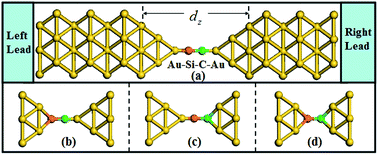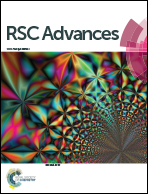Electronic transport properties of silicon carbide molecular junctions: first-principles study
Abstract
The contact geometry and electronic transport properties of a silicon carbide (SiC) molecule coupled with Au (1 0 0) electrodes are investigated by performing density functional theory plus the non-equilibrium Green's function method. We perform simulations of the Au–SiC–Au junction breaking process by calculating the conductance in four different anchoring geometries and obtain the equilibrium conductance and the projected density of states of junctions in the optimal position. The hollow–hollow configuration is found to be the most stable contact geometry with the largest conductance. From the calculation of restoring force and the spatial electron density differences after the structural break, we conclude that the Si–C bond is more stable than Au–C and Au–Si bonds in the single-molecular molecular junction. Moreover, the behavior of the junction currents is revealed under small bias. All junctions exhibit a linear current–voltage relationship, indicating characteristic metallic behavior at low bias voltage. The asymmetry of the I–V curves reflects the asymmetry of the molecule and the contact geometry. The origin of the transport spectrum of the junctions is discussed with the molecular projected self-consistent Hamiltonian (MPSH) states. The calculated results prove that the coupling morphology of the SiC molecule connected with electrodes, the distance and the external bias voltage have a great effect on the conductance of nanoscale junctions.


 Please wait while we load your content...
Please wait while we load your content...